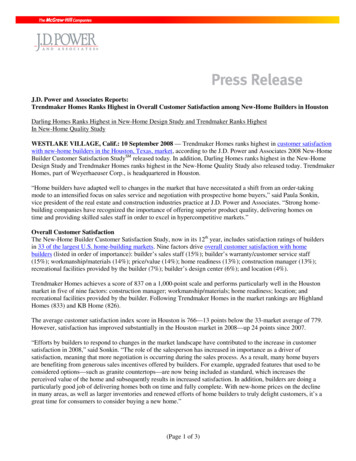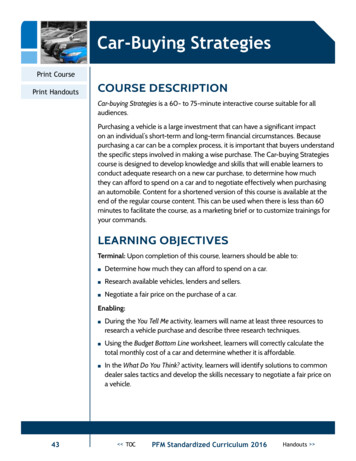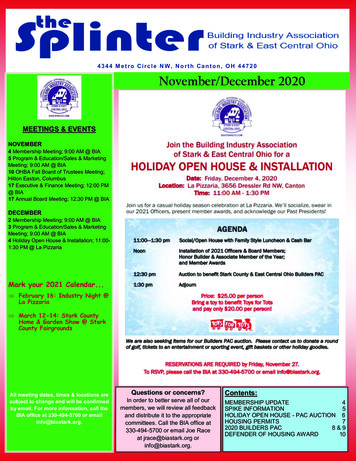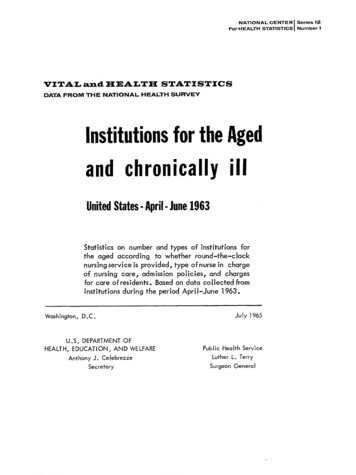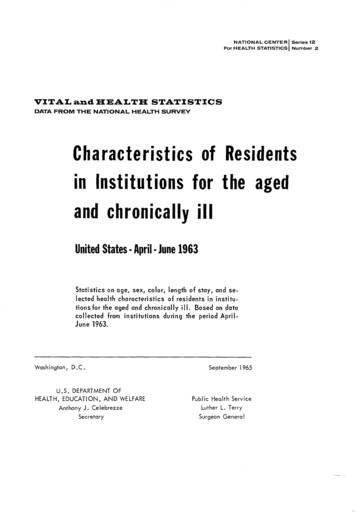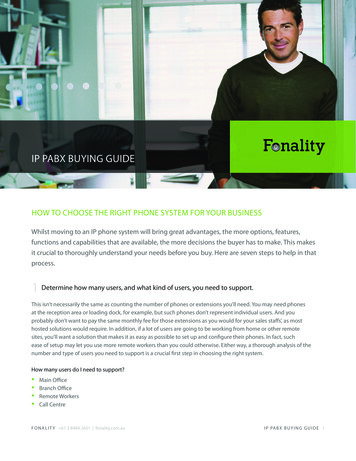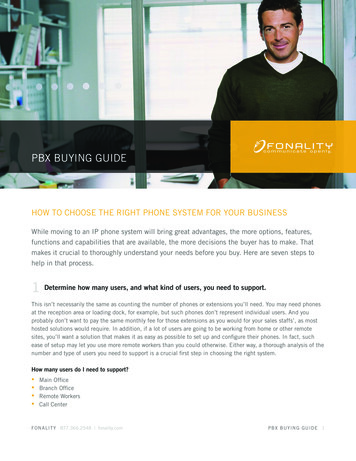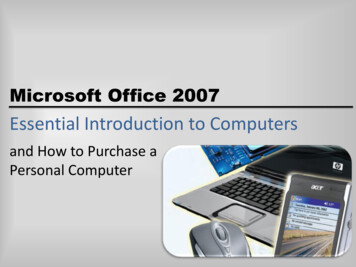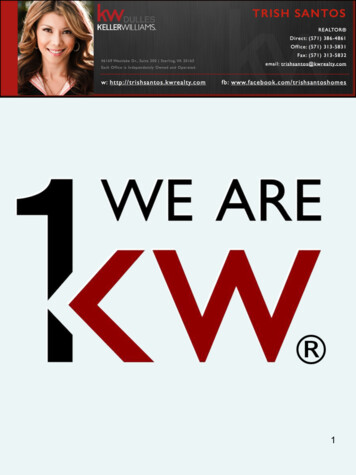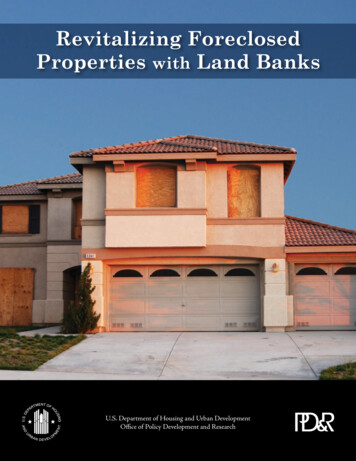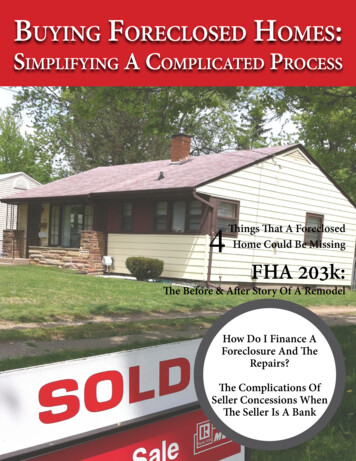
Transcription
Buying Foreclosed Homes:Simplifying A Complicated Process4Things That A ForeclosedHome Could Be MissingFHA 203k:The Before & After Story Of A RemodelHow Do I Finance AForeclosure And TheRepairs?The Complications OfSeller Concessions WhenThe Seller Is A Bank
Page 2Buying Foreclosed Homes:Simplifying a Complicated ProcessPage 3.So You Want to Buy a ForeclosurePage 4.Foreclosures: Vacant Homes Without CaretakersPage 5. Challenges Associated with Buying a ForeclosurePage 6.The House is Missing What?Page 7.How Do I Finance a Foreclosure and the Repairs?Page 10.FHA 203k: A Before & After StoryPage 12.More Home Buyer and Homeowner Resources to DownloadPage 13.How to Find a Mortgage ConsultantThis Guide Produced by:AmeriFirst Home Mortgagea division of AmeriFirst Financial Corp.950 Trade Centre Way, Suite 400Kalamazoo, MI 49024800.466.5626NMLS ID 110139www.amerifirst.com 2013NMLS # 110139AmeriFirst Home Mortgage800.466.5626
Page 3So You Want to Buy a ForeclosureForeclosures are down in 2013 compared to the last 5 years or so.However, foreclosed homes continue to exist andhome buyers still find them in the housing market forsale. Since these properties often come at a pricesignificantly lower than occupied homes for sale,a lot of home buyers consider them “good deals.”The goal of this guide is to offer tips and informationon what it means to buy a foreclosed home and dealwith the issues that generally come up when buyinga foreclosure. You will read about some of the thingsthat can go wrong when looking at foreclosed homes.You will also find some solutions to these issues.Keep in mind, we’re offering one point of view.Sometimes the best option may be to move on from that property, or to use cash to purchase andrenovate the house without a financial institution. At the end of the day, that’s your decision to makeas the buyer.Our goal is to help you sift through the issues and information about buying a bank-owned propertyso that you’re better prepared to make that decision. The information in this guide is meant as astarting point. As with any major decision, it’s a best practice to speak directly with a licensedprofessional about your particular situation. A real estate professional and a mortgage consultantlicensed in your state is a good place to start.OUR GOAL IS TO HELP YOU SIFTTHROUGHTHEISSUESANDINFORMATION ABOUT BUYING ABANK-OWNED PROPERTY SO THATYOU’RE BETTER PREPARED TOMAKE THAT DECISION.NMLS # 110139AmeriFirst Home Mortgage800.466.5626
Page 4Foreclosures: Vacant Homes Without CaretakersMany foreclosed homes sit vacantfor some period of time. It could be acouple months or it could be severalyears. The point to take away is thatthe house has no one to care ofmaintenance issues. If a “big bank”owns the home because of foreclosure,it rarely has a company taking care ofthings like winterization, leaks that mayoccur or critter infestations.If a personal seller lists a house,they’re likely to keep up on cleaning thegutters to avoid water in the roof or inthe basement. Someone selling a houselikely maintains the yard and keepsmice or other pests out of the house. If afurnace or water heater has a problem,the seller will fix it before listing thehouse most of the time.As a potential buyer of a foreclosedhome, you’re looking at a house thatcould possibly have water damage,broken windows, raccoons in the ceilingor peeling paint inside and out. Since noone is taking care of the house, no onewill make these repairs.Renovations, repairs and otherremodeling is left up to the buyer. Mostforeclosed homes sell “as-is.” Thismeans you buy it, no matter thecondition. Be prepared for an interestingtime.IF A “BIG BANK” OWNS THE HOME BECAUSE OF FORECLOSURE, ITRARELY HAS A COMPANY TAKING CARE OF THINGS LIKEWINTERIZATION, LEAKS THAT MAY OCCUR OR CRITTER INFESTATIONS.NMLS # 110139AmeriFirst Home Mortgage800.466.5626
Page 5Challenges Associated with Buying a ForeclosureYes, buying a foreclosed home can come with a unique set of challenges. This section is not meantto scare you off from your decision. Instead, we want to prepare you for some of the issues you mayface, the solutions available and the information needed to help you decide whether this purchase isworth it in the end.It’s Complicated – Seller ConcessionsBecause the seller in a foreclosure deal is a bank you may find yourself dealing with jargon andterms that seem nitpicky to the average buyer.For instance, an accepted practice in real estatedeals is for the seller (a private seller) to cover“closing costs.” This often can include pre-paidslike an escrow account. However, pre-paids arenot technically called closing costs. So if yourpurchase agreement with the bank calls forconcessions on closing costs, the bank can – andmay – come back with bad news at the closingtable and say it won’t pay for pre-paids. At the lastminute, you may find yourself stuck with a largebill to pay. Renegotiating at the closing table couldget sticky, but a trusted mortgage consultant mightbe able to get the bank to agree to the terms thatinclude the pre-paids. Every situation is differentof course, this is just one example.Another financial issue that may arise is title policies. In a traditional home purchase deal, the sellerpays for the owner’s title policy. Once that’s handled, the buyer takes care of the mortgage title policy.However, in a foreclosure deal the seller is the bank, and it often will not cover the owner’s policy.Instead, the buyer gets hit with both expenses, which could run in the thousand-dollar range.Time Delays and Doing Business RemotelyAdding to the complicated process is the fact that a bank selling a property is often removed fromthe local community. Real estate-owned (REO) properties are often owned by a national bankheadquartered in a major city in another state. The bank will not come to the closing table as aprivate seller would. Instead, the paperwork must be mailed to an office, looked over by committeeand eventually signed & delivered. This all takes time, so REO deals often take longer than traditionaldeals.RepairsFinally, repairs. We’ll cover this in more detail in the next section, “The House is Missing What?” butwe need to mention repairs and repair escrows. Many foreclosures are in need of repair for variousNMLS # 110139AmeriFirst Home Mortgage800.466.5626
Page 6reasons. Banks selling REO properties won’t let buyers go in before closing the deal in order to fixwhat needs fixing. Most lenders financing the purchase won’t close on the loan until certain things getfixed. We’re at a standstill at this point. However, a specialty lender like AmeriFirst Home Mortgagehas more flexibility, and can offer options like short-term repair escrows.A short-term repair escrow allows you as the buyer to put money into an account in order to makerepairs and renovations after the closing. You can then close the loan, and you have a short periodof time (approximately 2 weeks or so) to get the work done for a re-inspection. This allows you to buythe home, close on the loan and get the repairs done in a relatively quick time period, rather thanstarting from scratch.The House is Missing What?Whether it’s a homeowner who’s losing their home and is angry at the bank, or thieves casing avacant home, a foreclosed house may have several key items missing or severely damaged. We’veheard the horror stories of homes with kitchens damaged beyond recognition with missing sinks andcabinets; bathrooms with toilets and tubs destroyed; and living rooms with smashed windows andgraffiti painted on the walls. While these issues aren’t necessarily the norm (they’re more worst-casescenario) they do happen to foreclosed homes often enough that you should be aware of them.Vacant homes are prime targets for thieves. You’ll often see news reports that show thieves stealingcopper pipes, wiring, air conditioning units and other appliances for copper, scrap metal and otherblack-market activity. You might find a great deal on a foreclosed home only to find it’s missing thefurnace and some vital wiring.So, what happens when the houseyou fall in love with is missing vitalcomponents like a furnace, a waterheater and wiring; or it’s sportingbroken windows and graffiti?The Bottom Line: EquityThe question to ask during all of this is: “Is itworth it?” Buying a foreclosure can lead toyou as a homeowner gaining instant equity.After the process, the paperwork and therenovations – after the dust is settled – thishome you bought just may have thousandsof dollars in equity. If you’re buying a houseat a low price and put time and money into it,you’re raising the value. Not only does this help you in your home, but it helps your new neighbors bypotentially raising property values in your community.NMLS # 110139AmeriFirst Home Mortgage800.466.5626
Page 7How Do I Finance a Foreclosure and the Repairs?Now that you’ve read the worst-case scenarios, you may be thinking it’s a better idea to go for anon-foreclosed home. It’s up to you, but don’t run away just yet. You can solve many of the issuesyou’ve read about so far with something called a renovation mortgage.HomeStyle Renovation MortgageThe HomeStyle Renovation mortgage enables you as the borrower to buy a house with amortgage or get a limited cash-out refinance mortgage and receive funds to cover the costs ofrepairs, remodeling, renovations, or energy improvements to the property.There are no required improvements or restrictions on the types of repairs allowed or a minimumdollar amount for the repairs. Repairs or improvements, however, must be permanently affixed to thereal property and add value to the property.The house must be a one-to-four unit principal residence (you must live there), a one-unitsecond home (like a vacation cottage) or a one-unit investment property (you can be a landlord).Manufactured homes are not eligible for HomeStyle Renovation mortgages.The borrower can be an individual person living in the home, a for-profit investor, a non-profitinvestor or a local government agency that buys existing homes for renovation. A 10% down paymentis required – which includes the cost of the repairs as well as the purchase price.FHA 203kOne of the most flexible renovation mortgages is the option from FHA called the 203k loan. Thiscovers a Full 203k and the Streamline 203k, depending on the scope of the repairs and the kind ofrenovations you may finance. The 203k loan is more flexible on the kinds of repairs a home buyer canfinance, as well as the kind of house.With the 203k, a buyer like you can use the funds for simple upgrades to your home like a kitchenor bath improvement, or for more in-depth rehabilitation like rebuilding a house that is presentlyunlivable. You can even use a 203k rehabilitation loan to tear down an existing structure and builda new one using some portion of the existing foundation. Buyers can borrow up to 96.5% of theafter-improved appraised value. One of the requirement is that you use the 203k for primary,owner-occupied homes. Within the FHA 203k are 2 options for home buyers: the Full (or Standard)203k and the 203k Streamline.Full 203kThe Full 203k covers repairs of more than 35,000 including structural work. This can includemoving a load-bearing wall, adding a room or replacing the sill plate (due to insect damage). A Full203k requires a HUD-approved 203k consultant to help in the process.NMLS # 110139AmeriFirst Home Mortgage800.466.5626
Page 8Eligible Improvements for the Full 203kHomeowners can use the 203k program to finance “desired” repairs or upgrades such itemsas painting, room additions, decks and other items even if the home does not need any otherimprovements. Eligible improvements can range from relatively minor (must exceed 5,000 in cost)to virtual reconstruction: a home has been demolished or will be razed as part of rehabilitation iseligible, for example, provided that the existing foundation system remains in place.The types of improvements borrowers may make using the Full 203k include: All of the improvements listed below in the eligible improvements for a Streamlined 203k.Structural alterations and reconstruction, like room additions, repair of termite damage, majorremodeling of kitchens and bathrooms, finishing an attic or basement, adding a second story toa home, etc.Major landscaping and site improvement including correction of grading and drainageproblems, tree removal and repair of sidewalks and driveway, if they are a safety hazard to theproperty.Streamline 203kWhen you need to make limited repairs of less than 35,000 the Streamline 203k comes into play.Replacing carpet, repainting the house or buying new appliances fall under the Streamline 203k. Youdo not need to have a HUD consultant in a Streamline 203k (although it’s often a good idea to haveone running the show for you).Eligible improvements for a Streamline 203k include: Repair/Replacement of roofs, gutters and downspoutsRepair/Replacement/upgrade of existing HVAC systemsRepair/Replacement/upgrade of plumbing and electrical systemsRepair/Replacement of flooringMinor renovation, such as kitchens & baths, which do not involve structural repairsPainting, both exterior and interiorWeatherization, including storms windows and doors, insulation, weather stripping, etc.Purchase and installation of appliances, including free-standing ranges, refrigerators,washers/dryers, dishwashers and microwave ovensSeptic system and/or well repair or replacementAccessibility improvements for persons with disabilitiesLead-based paint stabilization or abatement of lead-based paint hazardsRepair/replace/add exterior decks, patios, porchesBasement waterproofing, finishing and renovation with does not involve structural repairsWindow and door replacements and exterior wall re-sidingIneligible Improvements include: Renovation involving structural changes, like moving a loadbearing wall, or new construction,like adding roomsLandscaping or FencingNMLS # 110139AmeriFirst Home Mortgage800.466.5626
Page 9 Work that will not start within 30 days of loan closing or will cause the borrower to be displacedfrom the home for more than 30 days or renovations that will take more than 6 months tocompleteLuxury items like swimming pools, hot tubs, tennis courts, etc.Repair EscrowWith this option repairs are done after closing. Here’s how it works: Obtain a bid from a licensed and insured contractor for only the required repairs (2 bidsrequired for FHA & VA). Buyers are not allowed to complete ANY repairs themselves.AmeriFirst reviews and approves repair escrow accordinglyClosing on the home occurs and escrow is funded. The key is “where does the money for therepair escrow come from?”Seller could fund the escrow account out of their closing proceedsBuyer could fund the escrow account by bringing additional funds to the closing.Rural Development Only – if the home appraises for more repairs can be financed into the loanup to the appraised value.Repairs are completed by the contractor. Now that we closed and ownership transferred theclock is ticking and the contractor has 2 weeks to get the repairs completed.Property is re-inspected by the appraiser and given a clean bill of health.Checks are cut to the contractor.The bottom line with buying foreclosed homes is that they may need some work, but you have optionsfor financing the renovations or taking care of them on your own.NMLS # 110139AmeriFirst Home Mortgage800.466.5626
Page 10FHA 203k: A Before & After StoryIn an article titled Before and After an FHA 203k: The Real Story we talked to a home buyer about herexperience, showing pictures of the projects she financed with the 203k loan. Below is the article in itsentirety to help show how a home can go from average to amazing.Before and after photos can tell a great story.This is especially true of home remodelingprojects. You don't really see the impact of abathroom remodeling project unless you seehow bad it was before. That's why so manyhome buyers don't really see the power ofthe FHA 203k home improvement loan.With the 203k loan, you can roll the costof this new bathroom (and so much more)directly into the mortgage that's paying forthe house itself. Let's take a look at onestory, and how an Ohio home buyer usedthe FHA 203k to buy a home and remodelmost of it - turning the house someone elsedecorated, into the home of her dreams.Laura H, the buyer, bought this southwest Ohio home in February. About 5 months later, she has anew home - after a 64,000 renovation project. This property received many updates including a newroof with a new gable, a new rear deck that had to be replaced, a substantial amount of drywall repairand painting, a new kitchen and appliance package, new flooring throughout, a new hauled-in watersystem, an additional exercise room built on the lower level and more.Joe Daly, AmeriFirst Home Mortgage renovation program manager (and licensed FHA 203kmortgage specialist) handled this particular deal. He says, "This house seemed to go on and on,looking bigger than the time I had walked through it originally with my borrower and their choicecontractor last November. It's just amazing."These pictures speak for themselves. They are a true example of what the 203k is! A living,breathing mortgage product that allows home buyers to actually participate in the renovation of ourcurrent housing stock (with foreclosed homes and vacant houses in need of some TLC), one homeat a time.Laura is excited, too. "Every time I look at the photos I am amazed at the transformation," shetells us. "Not having done this type of project before and never thinking of myself as much of aninterior designer, I am very proud of how it all turned out. Thanks go out to Joe Daly and everyonewho contributed at AmeriFirst to help make this dream come true!"NMLS # 110139AmeriFirst Home Mortgage800.466.5626
Page 11Joe says this kind of project really helps showreal estate agents, builders and buyers what theFHA 203k can do for all of them. "The propertywas a Fannie Mae foreclosure," Joe says. "Theborrower chose the FHA 203k due to its low downpayment option. We spoke of refinancing theircurrent mortgage to a lower rate and the possibilityof going conventional if the appraisal comes in highenough. A true real-life success story!"Laura's Realtor - Lori Pike of Sibcy Cline Realtors- says the FHA 203k is a great option for a lot ofhomes in today's market. Lori says a lot of agentsavoid the 203k like the plague because of bad pastexperiences. However, after attending a Realtor CE class on the 203k, she realized it didn't have tobe so bad. "People don't understand the process of the 203k," Lori told us. "Most Realtors shied awayfrom them - they're too much work and you can never seem to get the deal closed. But people areinspired by this project (with Laura). It went smoothly and it looks great. Plus the house is now wortha whole lot more then what they paid for it. It's a win-win for everyone."Joe gets excited about the benefits of thisrenovation loan program. "In summary, agreat win-win-win for everyone involved –Fannie Mae, Fannie Mae’s Listing Broker,the Realtor, buyer, buyer’s Realtor, thegeneral contractor and the myriad ofsubcontractors who also benefitted fromsomeone utilizing private dollars (FHA 203kmortgage monies) for their renovations,the community, the surrounding propertyowners, etc., etc I could go on and on."Click the link to see the full collection of FHA203k projects before and after photos.How Much Does the FHA 203k Cost?That's a good question. Of course, much of the answer depends on what you buy the house for, andhow much remodeling you choose to finance. But keep this number in mind: 6 per 1,000. For everythousand dollars in renovations you finance with the 203k loan, you'll add about 6 to your monthlyhouse payment.So this 64,000 remodeling project added about 380 dollars to the house payment. But if you'rebuying a home at far below the market value - as is often the case when buying a foreclosed home and you're adding value with the remodeling, then your home is going to increase in value by simplyfinishing the work. In other words, you'll have more home than what your payment indicates. It's awinning situation.NMLS # 110139AmeriFirst Home Mortgage800.466.5626
Page 12More Home Buyer and Homeowner Resources to DownloadAt AmeriFirst Home Mortgage we believe in educating home buyers and homeowners. Whetherit’s home improvement loans like the FHA 203k or a first home buyer’s guide, we offer severalcomplimentary eBooks. You can click one of the pictures below to find the eBook that’s right for you!NMLS # 110139AmeriFirst Home Mortgage800.466.5626
Page 13How to Find a Mortgage ConsultantFor more than 30 years, AmeriFirst Home Mortgage has helped first time home buyers realize thedream of leaving that rental behind, and owning a house. Whether it’s conventional lending, an FHAprogram, VA loan, USDA Rural Development or a 203k mortgage loan, the team at AmeriFirst ishere to find the right mortgage for you. See where AmeriFirst is licensed for mortgage lending at theAmeriFirst office locator here. http://www.amerifirst.com/office-locator We’re easy to find.The website: AmeriFirst.comWe’re on other social media sites as well.Read the blog and keep up with the industry so you can be an informed borrower.Copyright Notice & Legal Notice The AmeriFirst Home Mortgage Corporate Office950 Trade Centre Way, Suite 400 Kalamazoo, MI 49002 269.324.4240AmeriFirst Home Mortgage is a division of AmeriFirst Financial Corp.Photo courtesies via creative commons licensing:Page 3: foreclosure auction lender foreclosure foreclosurePage 4: peeling paintPage 5: negotiationPage 6: missing furnaceFeel free to share this eBook (AT NO COST OR OBLIGATION) with anyone you want to. All rights reserved. While attempts have been made to verifyinformation provided in this publication, neither the author nor the publisher assumes any responsibility for errors, omissions, or contradictory informationcontained in this document. This document is not intended as legal, accounting or investment advice. The reader of this document assumes allresponsibility for the use of these materials and information.Not all borrowers will qualify; contact us for more information on fees and terms.NMLS # 110139AmeriFirst Home Mortgage800.466.5626
Foreclosures: Vacant Homes Without Caretakers Many foreclosed homes sit vacant for some period of time. It could be a couple months or it could be several . occur or critter infestations. If a personal seller lists a hous
